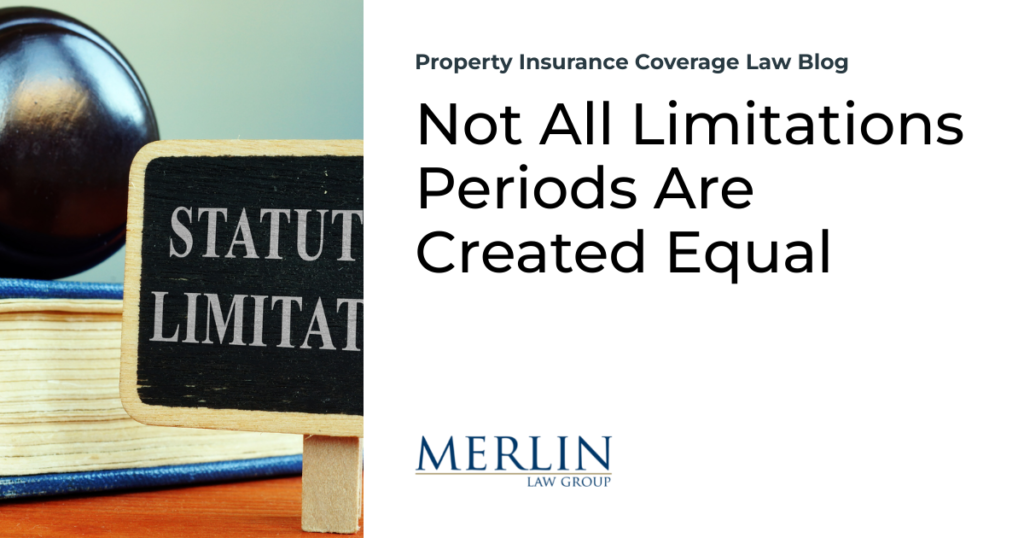Not All Limitations Periods Are Created Equal

If you search “Statute of Limitations” or “Suit Against Us” on the Merlin Property Insurance Coverage Law Blog (which I encourage you to do), you will have no shortage of reading material. While not a novel topic, the number of blogs should stress the subject’s importance.
As a policyholder or policyholder advocate, let this be a gentle reminder that you need to be aware of suit provisions and statutory deadlines to file suit if a conflict arises. Missing these deadlines could prevent you or your client from initiating a legal proceeding, should one be necessary.
However, calculating the limitations period is not always straightforward as not all limitations periods are created equal. It’s like shopping for a Rolex in-store versus the guy on the street corner who flashes the inside of his jacket…from a distance and with an untrained eye, the limitations period may at first appear to be the same based on the policy, but, upon further review, differences become apparent and some last quite a bit longer than others.
Limitations periods must often be calculated on a case-by-case basis due to specific facts of each claim, applying varying state laws. If you are unsure whether you or your client is running up against a deadline to file suit, reach out to an attorney for assistance, as the determination is not always black and white.
To better understand this, I will outline the application of the limitations period in California for a residential homeowners policy and then provide just a few of many considerations that may differ when calculating the limitations period for homeowners policies in other states.
California
In California, the statute of limitations for breach of a written contract (e.g., an insurance policy) is four years from the date the contract was broken. However, insurers are allowed to contractually shorten that timeframe via an insurance policy, and almost always do.
There are limits to how much an insurer may shorten that time frame, though. California Insurance Code Section 2071 sets out the language adopted as the standard form of fire insurance. Policies in the state must offer equivalent or better coverage. As to “Suit,” the code reads as follows:
No suit or action on this policy for the recovery of any claim shall be sustainable in any court of law or equity unless all the requirements of this policy shall have been complied with, and unless commenced within 12 months next after inception of the loss. If the loss is related to a state of emergency, as defined in subdivision (b) of Section 8558 of the Government Code, the time limit to bring suit is extended to 24 months after inception of the loss.
As a baseline, insurers in California may not contractually limit the timeframe to bring suit to less than 12 months from the inception of the loss, and 24 months if it was deemed a state of emergency.
This baseline applies regardless of the language in your California policy. However, since Cal. Ins. Code 2071 just sets the minimum bar, you should always read the policy to see if your insurer has provided more time than the minimum 12 months from the inception of the loss, if it has set one. This provision is often listed in the conditions section under a “Suit Against Us” or similarly titled section. For example, many homeowners policies will provide 24 months to bring suit, regardless of whether the loss was related to a state of emergency.
But the calculation does not stop there. California and some other states offer equitable tolling of the limitations period. Equitable tolling essentially acts as a pause/play button on the limitations “shot clock.” The “shot clock” starts counting down at the inception of the loss. However, the “shot clock” is paused as soon as the policyholder gives notice of the damage to the insurer. The shot clock does not begin to run again until coverage for the damage at issue is denied.1
A partial denial of a claim, however, is not always easily identifiable. If you or your client are contemplating legal action and are unsure of the limitations period, contact an attorney immediately to ensure you do not miss the deadline.
State-to-state considerations
Many differences exist on a state-to-state basis to determine whether the limitations period has run. The list below lists just a few of the considerations to keep in mind if you are a policyholder or a policyholder advocate in another state, or someone who conducts business in multiple states:
The statute of limitations for different causes of action varies by state.
Not all states allow for equitable tolling of claims. In these states, consider tolling agreements to extend the time to file suit if claim adjustment is ongoing.
Not all states allow for the contractual shortening of the statute of limitations.
There is a difference between statutory versus contractual limitation periods. Some states treat regulations, orders, and emergency rules regarding each differently.
Different limitation periods may apply for a contract cause of action (failure to pay benefits under an insurance policy) versus a breach of the covenant of good faith and fair dealing (unreasonable conduct).
The takeaway? Make sure you know what limitations period applies to your claim and how to calculate it. If you need assistance, ask.
To start, be sure to check out other blogs on the topic by using the search bar at https://www.propertyinsurancecoveragelaw.com/.
1 Prudential-LMI Com. Ins. v. Superior Court, 51 Cal. 3d 674 (Cal. 1990).







